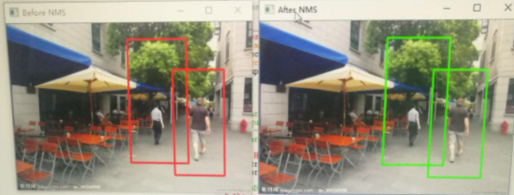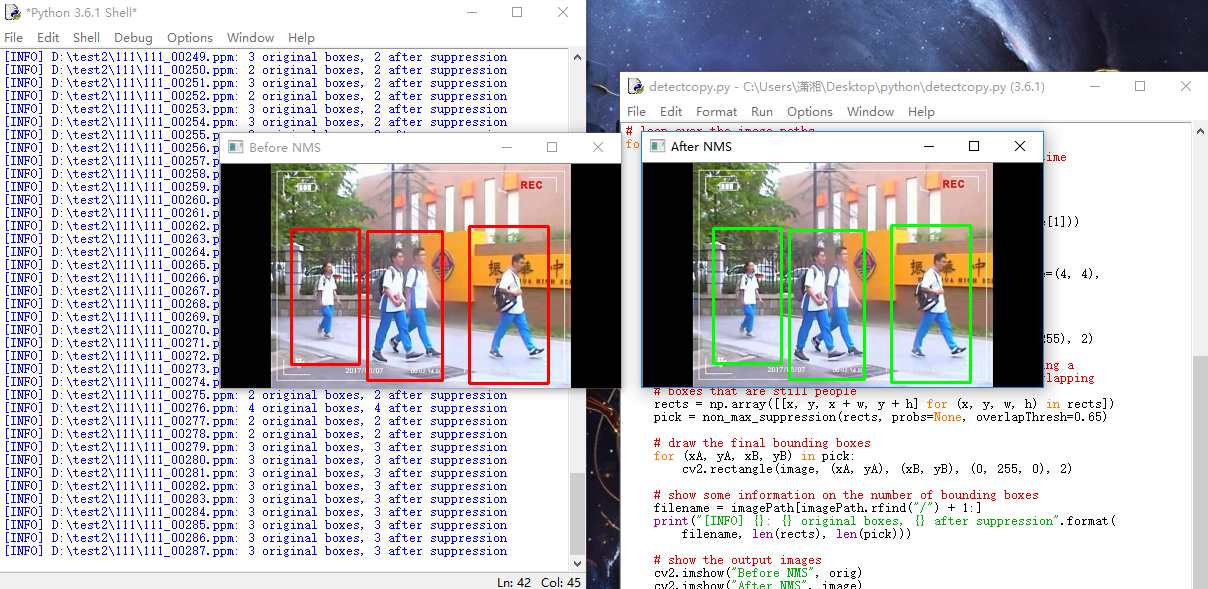利用HOG+SVM实现行人检测
利用HOG+SVM实现行人检测
很久以前做的行人检测,现在稍加温习,上传记录一下。
首先解析视频,提取视频的每一帧形成图片存到磁盘。代码如下
import os
import cv2
videos_src_path = 'D:\\test1'
videos_save_path = 'D:\\test2'
videos = os.listdir(videos_src_path)
videos = filter(lambda x: x.endswith('avi'), videos)
for each_video in videos:
print (each_video)
# get the name of each video, and make the directory to save frames
each_video_name, _ = each_video.split('.')
os.mkdir(videos_save_path + '/' + each_video_name)
each_video_save_full_path = os.path.join(videos_save_path, each_video_name) + '/'
# get the full path of each video, which will open the video tp extract frames
each_video_full_path = os.path.join(videos_src_path, each_video)
cap = cv2.VideoCapture(each_video_full_path)
frame_count = 1
success = True
while(success):
success, frame = cap.read()
print ('Read a new frame: ', success)
params = []
params.append(1)
params.append(1)
cv2.imwrite(each_video_save_full_path + each_video_name + "_%05d.ppm" % frame_count, frame, params)
frame_count = frame_count + 1
cap.release()
对于图片的行人检测应用了梯度方向直方图和支持向量机。代码如下
这段代码可以实现对行人的标记。
# import the necessary packages
from __future__ import print_function
from imutils.object_detection import non_max_suppression
from imutils import paths
import numpy as np
import argparse
import imutils
import cv2
import os
# initialize the HOG descriptor/person detector
hog = cv2.HOGDescriptor()
hog.setSVMDetector(cv2.HOGDescriptor_getDefaultPeopleDetector())
list = []
path = 'D:\\test2\\111'
videos = os.listdir(path)
videos = filter(lambda x: x.endswith('ppm'), videos)
for each in videos:
new_path=path + "\\" + each
list.append(new_path)
# loop over the image paths
for imagePath in list:
# load the image and resize it to (1) reduce detection time
# and (2) improve detection accuracy
image = cv2.imread(imagePath)
image = imutils.resize(image, width=min(400, image.shape[1]))
orig = image.copy()
# detect people in the image
(rects, weights) = hog.detectMultiScale(image, winStride=(4, 4),
padding=(8, 8), scale=1.05)
# draw the original bounding boxes
for (x, y, w, h) in rects:
cv2.rectangle(orig, (x, y), (x + w, y + h), (0, 0, 255), 2)
# apply non-maxima suppression to the bounding boxes using a
# fairly large overlap threshold to try to maintain overlapping
# boxes that are still people
rects = np.array([[x, y, x + w, y + h] for (x, y, w, h) in rects])
pick = non_max_suppression(rects, probs=None, overlapThresh=0.65)
# draw the final bounding boxes
for (xA, yA, xB, yB) in pick:
cv2.rectangle(image, (xA, yA), (xB, yB), (0, 255, 0), 2)
# show some information on the number of bounding boxes
filename = imagePath[imagePath.rfind("/") + 1:]
print("[INFO] {}: {} original boxes, {} after suppression".format(
filename, len(rects), len(pick)))
# show the output images
cv2.imshow("Before NMS", orig)
cv2.imshow("After NMS", image)
cv2.waitKey(1)
在这里应用了非极大值抑制方法(NMS),处理了重叠标记的问题。但是这里存在一个问题就是,部分两个人物距离过近或者产生重叠的情况下,优化后会将两个人标记称为一个人,这个问题还没有解决。
最后,将多张标记后的图片按一定帧数还原成视频,就完成了对视频的行人检测。 完整代码如下
# import the necessary packages
from __future__ import print_function
from imutils.object_detection import non_max_suppression
from imutils import paths
import numpy as np
import argparse
import imutils
import cv2
import os
'''
# construct the argument parse and parse the arguments
ap = argparse.ArgumentParser()
ap.add_argument("-i", "--images", required=True, help="path to images directory")
args = vars(ap.parse_args())
'''
# initialize the HOG descriptor/person detector
hog = cv2.HOGDescriptor()
hog.setSVMDetector(cv2.HOGDescriptor_getDefaultPeopleDetector())
list = []
path = 'D:\\test2\\111'
videos = os.listdir(path)
videos = filter(lambda x: x.endswith('ppm'), videos)
for each in videos:
new_path=path + "\\" + each
list.append(new_path)
fourcc = cv2.VideoWriter_fourcc(*'I420')
videoWriter = cv2.VideoWriter('D:\\test2\\111\\saveVideo.avi',-1,24,(720,404))
# loop over the image paths
for imagePath in list:
# load the image and resize it to (1) reduce detection time
# and (2) improve detection accuracy
image = cv2.imread(imagePath)
if image is None:
break
image = imutils.resize(image, width=min(400, image.shape[1]))
orig = image.copy()
# detect people in the image
(rects, weights) = hog.detectMultiScale(image, winStride=(4, 4),
padding=(8, 8), scale=1.05)
# draw the original bounding boxes
for (x, y, w, h) in rects:
cv2.rectangle(orig, (x, y), (x + w, y + h), (0, 0, 255), 2)
# apply non-maxima suppression to the bounding boxes using a
# fairly large overlap threshold to try to maintain overlapping
# boxes that are still people
rects = np.array([[x, y, x + w, y + h] for (x, y, w, h) in rects])
pick = non_max_suppression(rects, probs=None, overlapThresh=0.65)
# draw the final bounding boxes
for (xA, yA, xB, yB) in pick:
cv2.rectangle(image, (xA, yA), (xB, yB), (0, 255, 0), 2)
# show some information on the number of bounding boxes
filename = imagePath[imagePath.rfind("/") + 1:]
print("[INFO] {}: {} original boxes, {} after suppression".format(
filename, len(rects), len(pick)))
# show the output images
cv2.imshow("Before NMS", orig)
cv2.imshow("After NMS", image)
videoWriter.write(image)
cv2.waitKey(1)
videoWriter.release()
运行截图如下


优化:预处理部分图像结果存在的磁盘上,导致运行速度偏难,可以先加载到内存中,以便加速。
关于视频,没有进行上下文处理,只是单纯的将图片合成视频,没有相互关联起来。




 浙公网安备 33010602011771号
浙公网安备 33010602011771号